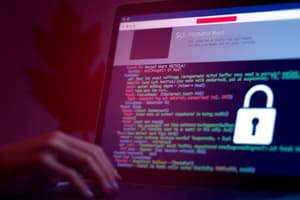Podcast
Questions and Answers
What is the average amount spent by Canadian organizations to resolve damage done by cyber attacks?
What is the average amount spent by Canadian organizations to resolve damage done by cyber attacks?
- $10 million
- $15 million
- $5 million
- $9.25 million (correct)
What percentage of Canadian businesses reported being impacted by a cyber security incident in 2019?
What percentage of Canadian businesses reported being impacted by a cyber security incident in 2019?
- 21% (correct)
- 15%
- 30%
- 25%
What percentage of businesses impacted by incidents reported them to the police?
What percentage of businesses impacted by incidents reported them to the police?
- 6%
- 10%
- 12% (correct)
- 15%
What type of businesses are most likely to face cyber threat activity?
What type of businesses are most likely to face cyber threat activity?
What is the primary motivation for cybercrimes experienced by Canadian businesses?
What is the primary motivation for cybercrimes experienced by Canadian businesses?
What is required by Canada’s Personal Information Protection of Electronic Documents Act (PIPEDA)?
What is required by Canada’s Personal Information Protection of Electronic Documents Act (PIPEDA)?
What is an example of technology being the target of a crime?
What is an example of technology being the target of a crime?
What is ransomware?
What is ransomware?
What is the purpose of a denial-of-service (DoS) attack?
What is the purpose of a denial-of-service (DoS) attack?
What is spyware?
What is spyware?
Which of these is NOT a type of cybercrime mentioned in the text?
Which of these is NOT a type of cybercrime mentioned in the text?
What is the main reason online gambling operations are attractive targets for denial of service attacks?
What is the main reason online gambling operations are attractive targets for denial of service attacks?
Which of the following is NOT a common tactic used in phishing attacks?
Which of the following is NOT a common tactic used in phishing attacks?
What is the main purpose of spoofing in cybercrime?
What is the main purpose of spoofing in cybercrime?
What is the estimated annual loss in revenue due to online piracy worldwide?
What is the estimated annual loss in revenue due to online piracy worldwide?
Which of the following is a key component of the Information Security Triad?
Which of the following is a key component of the Information Security Triad?
What is the primary aim of a Denial of Service (DoS) attack?
What is the primary aim of a Denial of Service (DoS) attack?
Which of the following is NOT an example of a cybercrime that uses technology?
Which of the following is NOT an example of a cybercrime that uses technology?
What is the term for a criminal who lures individuals into providing confidential information?
What is the term for a criminal who lures individuals into providing confidential information?
What is the main focus of the Information Security Triad?
What is the main focus of the Information Security Triad?
Which of the following is NOT a factor used in authentication?
Which of the following is NOT a factor used in authentication?
What is the primary concern addressed by confidentiality in the CIA Triad?
What is the primary concern addressed by confidentiality in the CIA Triad?
Which authentication method is considered the most secure?
Which authentication method is considered the most secure?
What is an example of an unintentional threat to information integrity?
What is an example of an unintentional threat to information integrity?
Which of the following is a common example of a tool used for authentication?
Which of the following is a common example of a tool used for authentication?
What does 'Need to Know' (NTK) refer to in the context of confidentiality?
What does 'Need to Know' (NTK) refer to in the context of confidentiality?
Which of the following is NOT a category of tools used to ensure information security?
Which of the following is NOT a category of tools used to ensure information security?
What is the main purpose of information availability within the CIA Triad?
What is the main purpose of information availability within the CIA Triad?
Which of the following is an example of information that requires immediate availability?
Which of the following is an example of information that requires immediate availability?
What is a key difference between passwords and biometrics in terms of authentication?
What is a key difference between passwords and biometrics in terms of authentication?
What is the primary focus of Chapter 8?
What is the primary focus of Chapter 8?
What does the information security triad refer to?
What does the information security triad refer to?
Which of the following would NOT be considered cybercrime?
Which of the following would NOT be considered cybercrime?
Which measure is least effective in securing personal computing environments?
Which measure is least effective in securing personal computing environments?
What is a key impact of cybercrime on organizations?
What is a key impact of cybercrime on organizations?
What aspect of cybersecurity primarily deals with identifying security breaches?
What aspect of cybersecurity primarily deals with identifying security breaches?
Which of the following is NOT a component of information security tools?
Which of the following is NOT a component of information security tools?
What is one of the main purposes of cybersecurity measures?
What is one of the main purposes of cybersecurity measures?
What is the primary reason hackers attempt to crack passwords?
What is the primary reason hackers attempt to crack passwords?
What is the recommended frequency for changing passwords?
What is the recommended frequency for changing passwords?
What is pretexting in the context of password security?
What is pretexting in the context of password security?
What is the CIA triangle composed of?
What is the CIA triangle composed of?
What is the purpose of authentication in information security?
What is the purpose of authentication in information security?
What is a good password policy?
What is a good password policy?
What is the purpose of access controls in information security?
What is the purpose of access controls in information security?
What is the main focus of the Information Security Triad?
What is the main focus of the Information Security Triad?
What is the purpose of encryption in information security?
What is the purpose of encryption in information security?
Why is it important to consider the CIA triangle when developing security policies?
Why is it important to consider the CIA triangle when developing security policies?
What is the primary goal of access control in information security?
What is the primary goal of access control in information security?
What is the term for a set of rules applied by network owners to restrict usage?
What is the term for a set of rules applied by network owners to restrict usage?
What is the purpose of backup procedures in information security?
What is the purpose of backup procedures in information security?
What is biometric authentication an example of?
What is biometric authentication an example of?
What is the goal of confidentiality in the CIA Triad?
What is the goal of confidentiality in the CIA Triad?
What is an example of a cybercrime that uses technology?
What is an example of a cybercrime that uses technology?
What is the purpose of environmental monitoring in information security?
What is the purpose of environmental monitoring in information security?
What is the primary aim of a firewall in information security?
What is the primary aim of a firewall in information security?
What is the purpose of employee training in information security?
What is the purpose of employee training in information security?
What is the primary concern addressed by availability in the CIA Triad?
What is the primary concern addressed by availability in the CIA Triad?
What is the primary benefit of multi-factor authentication?
What is the primary benefit of multi-factor authentication?
What does access control primarily determine?
What does access control primarily determine?
What is a major drawback of the Access Control List (ACL) model?
What is a major drawback of the Access Control List (ACL) model?
How does Role-Based Access Control (RBAC) simplify user management?
How does Role-Based Access Control (RBAC) simplify user management?
What is the function of encryption in data security?
What is the function of encryption in data security?
What type of encryption involves sharing an encryption key between two parties?
What type of encryption involves sharing an encryption key between two parties?
Which of the following is NOT a method to prevent unauthorized data access?
Which of the following is NOT a method to prevent unauthorized data access?
What is a limitation of using ACLs in large organizations?
What is a limitation of using ACLs in large organizations?
Which of the following describes multi-factor authentication best?
Which of the following describes multi-factor authentication best?
What advantage does RBAC provide over ACL?
What advantage does RBAC provide over ACL?
What is a critical consideration when planning data backups to avoid total data loss during a disaster?
What is a critical consideration when planning data backups to avoid total data loss during a disaster?
What is the purpose of testing data restoration as part of a backup plan?
What is the purpose of testing data restoration as part of a backup plan?
How can an Uninterruptible Power Supply (UPS) assist in preventing data loss?
How can an Uninterruptible Power Supply (UPS) assist in preventing data loss?
What defines an 'alternate' or 'hot' site in disaster recovery planning?
What defines an 'alternate' or 'hot' site in disaster recovery planning?
What is one of the recommended actions to enhance cyber security for businesses?
What is one of the recommended actions to enhance cyber security for businesses?
What is the primary function of an Intrusion Detection System (IDS)?
What is the primary function of an Intrusion Detection System (IDS)?
Which of the following best describes the role of two-factor authentication?
Which of the following best describes the role of two-factor authentication?
Which of the following is an essential component of physical security?
Which of the following is an essential component of physical security?
Why is it advised to keep operating systems and applications up to date?
Why is it advised to keep operating systems and applications up to date?
Why is environmental monitoring important in a physical security plan?
Why is environmental monitoring important in a physical security plan?
What should individuals do to protect their data from external risks when using public Wi-Fi?
What should individuals do to protect their data from external risks when using public Wi-Fi?
Which of the following describes a common misconception about Intrusion Detection Systems (IDS)?
Which of the following describes a common misconception about Intrusion Detection Systems (IDS)?
What is a crucial characteristic of strong passwords?
What is a crucial characteristic of strong passwords?
What should organizations assess when considering the impact of downtime?
What should organizations assess when considering the impact of downtime?
What is one of the baseline controls businesses should implement regarding employee training?
What is one of the baseline controls businesses should implement regarding employee training?
Which of the following is NOT a recommended practice for data backup?
Which of the following is NOT a recommended practice for data backup?
What is a primary method to protect hardware resources from physical theft?
What is a primary method to protect hardware resources from physical theft?
Why is relying solely on a simple user ID and password considered inadequate for security?
Why is relying solely on a simple user ID and password considered inadequate for security?
What should individuals use to secure their online accounts effectively?
What should individuals use to secure their online accounts effectively?
What is a significant risk associated with using unfamiliar USB flash drives?
What is a significant risk associated with using unfamiliar USB flash drives?
What is a necessary measure to prevent server failures in an organization?
What is a necessary measure to prevent server failures in an organization?
What should employees be trained to do with their laptops while traveling?
What should employees be trained to do with their laptops while traveling?
What is one key aspect of an effective information security policy?
What is one key aspect of an effective information security policy?
What does an Acceptable Use Policy (AUP) typically address?
What does an Acceptable Use Policy (AUP) typically address?
What is a common consequence of violating an Acceptable Use Policy in an organization?
What is a common consequence of violating an Acceptable Use Policy in an organization?
How can organizations balance security with usability?
How can organizations balance security with usability?
What is a potential downside of overly complex password policies?
What is a potential downside of overly complex password policies?
What is a critical first step in developing an organization's security strategy?
What is a critical first step in developing an organization's security strategy?
What should organizations consider when designing security measures?
What should organizations consider when designing security measures?
What is one aspect not typically included in an Acceptable Use Policy?
What is one aspect not typically included in an Acceptable Use Policy?
What is identity theft?
What is identity theft?
Which statement best describes multifactor authentication?
Which statement best describes multifactor authentication?
What is the primary function of an Intrusion Detection System (IDS)?
What is the primary function of an Intrusion Detection System (IDS)?
What does physical security primarily focus on?
What does physical security primarily focus on?
What technique is used in phishing attacks?
What technique is used in phishing attacks?
Which of the following best defines RBAC?
Which of the following best defines RBAC?
How does public key encryption work?
How does public key encryption work?
What is a common method used in social engineering attacks?
What is a common method used in social engineering attacks?
What is the purpose of a Universal Power Supply (UPS)?
What is the purpose of a Universal Power Supply (UPS)?
Which of the following statements about spoofing is correct?
Which of the following statements about spoofing is correct?
What is the primary purpose of a firewall in a network?
What is the primary purpose of a firewall in a network?
In public key encryption, how does a recipient decrypt a message?
In public key encryption, how does a recipient decrypt a message?
What is the primary difference between a hardware firewall and a software firewall?
What is the primary difference between a hardware firewall and a software firewall?
What is a VPN (Virtual Private Network) used for in a corporate network?
What is a VPN (Virtual Private Network) used for in a corporate network?
Why are backups an essential part of a comprehensive information security plan?
Why are backups an essential part of a comprehensive information security plan?
What is a key difference between public key encryption and symmetric key encryption?
What is a key difference between public key encryption and symmetric key encryption?
Which of the following is NOT a common component of a good backup plan?
Which of the following is NOT a common component of a good backup plan?
What is the primary goal of an anti-virus program?
What is the primary goal of an anti-virus program?
What is the main benefit of using a DMZ (Demilitarized Zone) in a network?
What is the main benefit of using a DMZ (Demilitarized Zone) in a network?
What is the purpose of a router in a network?
What is the purpose of a router in a network?
Flashcards are hidden until you start studying
Study Notes
Chapter Overview
- Focuses on the importance of cybersecurity in business and personal computing.
- Addresses the increasing target nature of digital devices due to their integration in daily activities.
- Highlights security threats, preventive measures, and tools used for information systems security.
Cybercrime
- Cybercrime involves illegal activities conducted using or targeting computers.
- In Canada, organizations reportedly spent an average of $9.25 million to resolve damages from cyber attacks (2019).
- 21% of Canadian businesses faced cybersecurity incidents, with only 12% reporting these to authorities.
- Small and medium enterprises are particularly vulnerable to immediate financial and privacy risks from cyber threats.
- Cybercriminals target organizations for sensitive customer data, financial information, and proprietary knowledge.
- Consequences of cybercrime include reputational harm, productivity losses, intellectual property theft, and recovery costs.
Personal Information Protection
- PIPEDA mandates private businesses in Canada to safeguard personal data and report any breaches to the privacy commissioner.
- Organizations must understand legal requirements related to personal data handling to minimize impacts of cyber incidents.
Types of Cybercrime
- Targeted Technology Crimes: Examples include malware (viruses, spyware, ransomware) and DoS/DDoS attacks.
- Technology-Facilitated Crimes: Include identity theft, social engineering, hacking, phishing, spoofing, and software piracy.
- Malware encompasses programs designed to disrupt or steal data; ransomware encrypts data, demanding payment for access.
- DDoS attacks involve multiple computers flooding a target to disrupt authorized access.
The Information Security Triad (CIA Triad)
- Confidentiality: Ensures that only authorized users can access certain information.
- Integrity: Guarantees that data remains unchanged and accurately reflects its intended meaning, protecting against unauthorized alterations.
- Availability: Information should be accessible for authorized users within appropriate timeframes, depending on the context.
Tools for Security
- Organizations utilize various tools categorized into authentication, prevention, and detection tools to ensure information security.
Authentication
- Authentication verifies user identity through:
- Passwords: Most common but may be easily compromised.
- Out-of-Wallet Questions: Security questions known only to the user.
- Tokens: Physical items (like keys/cards) for identification, which can be lost.
- Biometrics: Uses unique physical traits for identification (e.g., fingerprints).
- Multi-factor Authentication: Combines multiple identification factors for enhanced security.
Prevention Measures
-
Access control, encryption, firewalls, antivirus programs, and backups help prevent unauthorized access and data loss.
-
Access Control: Regulates who can access and interact with information.
- Access Control List (ACL) assigns specific actions to users but can be challenging to manage with increasing users and resources.
- Role-Based Access Control (RBAC) assigns permissions based on user roles, allowing simplified management.
-
Encryption: Scrambles data to make it unreadable without a decryption key, enhancing data security during transmission.
- Symmetric key encryption shares one key between sender and receiver, while public key encryption involves a pair of keys.
-
Firewalls: Filter incoming and outgoing network traffic based on established security rules, available as both hardware and software options.### VPNs and Access Security
-
VPNs enable remote users to bypass firewalls and access corporate internal networks securely.
-
Combines software and security measures to maintain overall network security during off-site access.
Antivirus Programs
- Antivirus software detects and removes malicious programs like viruses and spyware.
- Functions as a reactive measure, requiring updates to recognize new threats.
Backup Strategies
- Essential for protecting organizational data, including server and individual computer backups.
- Key components of a backup plan include:
- Understanding information assets and their storage locations (servers, hard drives, cloud).
- Regular backups based on data criticality; daily backups for critical data, weekly for less important.
- Offsite storage to protect against disasters, ensuring backups are separate from original data.
- Regular testing of backup restoration processes to confirm functionality and reliability.
Physical and Operational Security
- Physical security measures protect hardware and networking components, vital for data integrity.
- Implementation includes:
- Locked doors and restricted access to sensitive areas.
- Physical intrusion detection via security cameras.
- Environmental monitoring to ensure optimal conditions for sensitive equipment.
- Employee training against theft, particularly during travel.
Security Policies
- Security policies are vital administrative controls establishing guidelines for resource use.
- Must comply with legal and regulatory requirements relevant to the organization.
- Acceptable Use Policies (AUPs) delineate allowable actions while using organizational resources.
Incident Response and Network Security Measures
- Organizations should develop incident response plans as part of their cybersecurity strategy.
- Employ multiple security measures including:
- Regular software updates and enabling security software.
- Strong user authentication, employee training, and data backup protocols.
- Secure configurations for devices and cloud services.
Password Security
- Effective password policies should require complexity, regular changes, and avoidance of reuse.
- Employee training is crucial to prevent social engineering tactics used to steal passwords.
Cybersecurity Framework
- The CIA triangle (Confidentiality, Integrity, Availability) is foundational for security policy development.
- Tools for enhancing security include authentication measures, firewalls, and intrusion detection systems.
Cybercrime
- Defined as illegal acts using computers or targeting them.
- The increase of cybercrime correlates with the growing reliance on technology in businesses.
User Position on Data Privacy
- Organizations need to consider user rights and data handling ethics.
- Users should maintain control over their personal data, with organizations held accountable for ethical management.
Key Terms Summary
- Access Control: Limits user access to information based on permissions.
- Acceptable Use Policies (AUP): Rules governing the acceptable use of resources.
- Authentication: Verifying user identity through knowledge, tokens, or biometrics.
- Backup: Creating copies of data for recovery: a critical disaster recovery strategy.### Biometric Authentication
- Verifies identity using unique biological traits, e.g., fingerprints.
Confidentiality
- Ensures information access is restricted to authorized individuals.
Cybercrime
- Refers to illegal activities using a computer or targeting a computer.
Denial-of-Service (DoS) Attack
- Prevents authorized users from accessing a web server.
Employee Training
- Essential for securing equipment; employees should safeguard laptops during travel.
Encryption
- Encodes data during transmission/storage, ensuring only authorized access.
Environmental Monitoring
- High-value equipment like servers must be monitored for temperature, humidity, and airflow to prevent failure.
Firewall
- Increases network security by blocking unauthorized data and messages.
Hacking
- Involves unauthorized access to a computer.
Identity Theft
- Criminals exploit personal information for unauthorized use.
Integrity
- Guarantees that accessed information is unaltered and accurate.
Intrusion Detection System (IDS)
- Identifies potential attacks on the network.
Physical Security
- Protects hardware and networking components holding sensitive information.
Locked Doors
- Secure valuable information assets in controlled-access locations to prevent physical theft.
Multifactor Authentication
- Requires multiple independent authentication methods for identity verification.
Phishing
- Deceptive emails posing as trusted sources to extract personal information.
Physical Intrusion Detection
- Monitors secure locations with security cameras to detect unauthorized access.
Piracy
- Illegal copying and distribution of software is classified as a computer crime.
Public Key Encryption
- Utilizes a pair of keys (public and private) for secure message transmission.
RBAC (Role-Based Access Control)
- Users assigned roles determine access rights, simplifying security management.
Secured Equipment
- Devices should be locked to prevent theft of sensitive data.
Spoofing
- Disguising identity by altering the source address of messages to appear authorized.
Social Engineering
- Manipulates individuals into revealing confidential information.
Symmetric Key Encryption
- Both parties share the encryption key to secure information transmission.
Universal Power Supply (UPS)
- Provides battery backup for critical system components, preventing data loss during power failures.
VPN (Virtual Private Network)
- Enables external users to access internal corporate networks securely by bypassing firewalls.
Studying That Suits You
Use AI to generate personalized quizzes and flashcards to suit your learning preferences.




